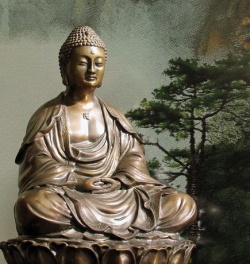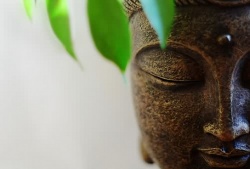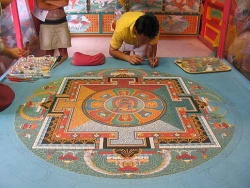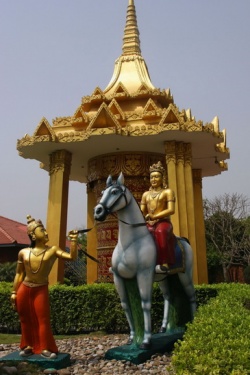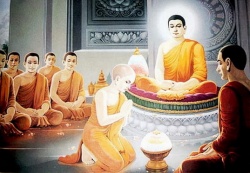Buddhism and Its Spread Along the Silk Road
Besides silk, paper and other goods, the Silk Road carried another commodity which was equally significant in world history. Along with trade and migration, the world's oldest international highway was the vehicle which spread Buddhism through Central Asia. The transmission was launched from northwestern India to modern Pakistan, Afghanistan, Central Asia, Xinjiang (Chinese Turkistan), China, Korea and Japan. Buddhism not only affected the lives and cultures on those regions but also left us with a world of wonders in arts and literature. (Figure on the right: Princes from [[Wikipedia:Central Asian|Central Asian]] states in Lamentation, Dunhuang Cave 158. After Sakyamuni entered nirvana, princes of different [[Wikipedia:Central Asian|Central Asian]] states gathered to express their grief, crying, beating their chests, piercing themselves with swords or knives, or cutting off their noses or ears. This painting not only depicts their devotions to Buddha, but also accurately presents the appearances, garments and customs of different nations along the Silk Road and the history of cultural exchange between them.)
According to legend, the Buddha (The Awakened), or Gotama (Sanskrit) lived in northern India in the 6th century BC. Gotama was his family name and his personal name was Siddhattha in Pali language. He was born in a noble family and ancient lineage, the Sakyas. A title by which Siddhattha came to be known as 'the Sage of the Sakyas', Sakyamuni. To the West, he is known as the Buddha.
What is known of the Buddha's life is based mainly on the evidence of the canonical texts, the most extensive and comprehensive of which are those written in Pali, an ancient Indian language. According to the canon, Buddha's birth place was Lumbini, near the small city of Kapilavastu on the borders of Nepal and India. In his twenties, he renounced his life in the palace and left home in search of enlightenment after witnessing sights of suffering, sickness, aging and death. He achieved Enlightenment at Bodh Gaya and gave the first sermon at Sarnath. He spent his remaining life in travelling, teaching and spreading Buddhism.
It is not clear when the first Buddhist community was established in India. By the time of Buddha's death at the age of 80 he had become a famous and respected figure and had allies and supporters among rich and poor. In 484 BC, seven days after the Buddha's death at Kushinagara (modern Kasia), his body was cremated and the relics were divided equally among eight clans. Each of these built a sacred cairn over the relics, a form of memorial known in India as a stupa, which later became the focus for Buddhists' devotions. For the next two centuries, there was a steady growth of Buddhism in India.
Not long after the Buddha's death, the followers gathered at Rajagriha for the first general council. The second council was held in Vaishali one hundred years after the death of Buddha. The third one is said to be held in Pataliputra in the time of the Mauryan king Ashoka.
The Indian King Ashoka (273-232 BC), the grandson of the founder of the Mauryan dynasty, demonstrated his conversion to Buddhism by vigorously promulgating the religion across India. His edicts were carved on pillars of stone and wood, from Bengal to Afghanistan and into the south. He celebrated the distribution of the ashes of the Buddha, according to legend, placed inside 84,000 stupas. His best-known dedications are the Sarnath lion capital imprinted on India's currency and the Wheel of the Law at the center of the national flag of India. Ashoka's empire extended to the northwestern borders of the Punjab. The Buddhist monks were free to move throughout the whole area. As the result, the Buddhist community probably had reached the Hellenized neighbor, the Kushan/Bactrian kingdom, by the end of Ashoka's reign.
- The Dissemination of Buddhism by Kushan/Bactria
The Kushans dominated the areas of Hindu Kush into Kabul, Gandharan Pakistan and north-western India. They controlled the trade between India, China, Parthia and the Roman Empire. This provided an ideal medium for the further spread of Buddhism. From the 2th century BC to the 2nd century AD, Buddhism gradually developed in northwestern India and the great Kushan ruler, Kanishak reigned from 144-172, was converted. Under his influence, Gandharaa Buddhist settlement, flourished and created a distinctive Graeco-Buddhist art form, which affected the arts in Central Asia and eastward in the first four centuries of our era, which is to be discussed later.
According to Prof. A. Litvinskii, Buddhism had reached Merv and Parthia as early as Achaemenid times. The Mahavamsa, the Great Chronicle of Ceylon described that Parthian and Alexandrian delegates were in attendance at a Buddhist council held by King Duttha Gamani (108-77BC). With the extension of Kushan influence, Buddhism further penetrated the realm of the Parthians and Sassanians. Parthian's Buddhist faith was also confirmed by the Chinese records of the missions of the Parthian Buddhist preachers, An-Shih-Kao and An Hsuan during the 2nd century.
Bactria was introduced to Buddhism by the 1st century AD as suggested by the Buddhist settlement discovered at Airtam, 18 kilometers northwest of Termez. For the next few centuries Kushan/Bactrian Buddhist centers were expanded to Hadda, Bamiyan and Kondukistan. Among them the most important one is Bamiyan, 240 kilometers northwest of Kabul, Afghanistan. It became one of the greatest Buddhist monastic communities in all Central Asia by the 4th century. At the west stands the 53 meter Buddha (Figure on the left), still the largest statue in the world. With its strategic location at the intersection of roads to Persia, India, Tarim basin, and China, it developed an art style with a fusion of Iranian, Indian, Gandharan and local style into an independent mode of its own. This style of Buddhist art traveled eastward and was quickly adopted at Kizil, Xinjiang and ultimately Dunhuang. Buddhism reached the height of its power in the 8th and 9th centuries in Afghanistan before it fell to the Arabs.
In terms of the distribution of Buddhist schools, we rely on the travel accounts of the pilgrims and envoys. Hadda was a center of Hinayana (Small Vehicle). Bamiyan, described by Xuan Zang in the 7th century, practiced Hinayana Buddhism whereas by 727 AD, another visitor Hui-chao described the monastery devoting to Mahayana (Big Vehicle) Buddhism. Other centers such as Kapisa, Kakrak and Fondukistan seemed to also follow Mahayana Buddhism, from the evidence of their paintings and sculptures.
- Buddhism in the Tarim Basin
We learn that by the 7th century all the small kingdoms of the Tarim region had been entirely won over to Buddhism, which brought with it so much of Indian culture that Sanskrit had become the religious language. As Buddhism advanced towards the Tarim basin, Kashgaria with Yarkand and Khotan in the west, Tumsuk, Aksu and Kizil in the north, Loulan, Karasahr and Dunhuang in the east, and Miran and Cherchen in the south became important centers of Buddhist art and thought. The Buddhist texts were translated from Sanskrit into various local Indo-European dialects such as Tocharian or Kuchean. By 658 Kucha developed to be a leading center of Hinayana Buddhism and the paintings were found at the cave temples of Kizil (near Kucha) (Figure on the right: Goddess and Celestial Musician, Wall-painting at Kizil cave. 600-605 AD) dated from the 1st to 8th centuries. The early art form in the Tarim area were strongly Indo-Persian in style, but Persian elements were gradually overlaid by the Chinese in the 6th century after Tang's power dominated the Tarim basin.
It is impossible to make any general rules about the precise schools of Buddhism that flourished in the Tarim basin, but the early pilgrims who traveled there gave some clues. Fa-hsien and Xuan Zang appeared to indicate that most of the kingdoms such as Kashgar, Kizil, Karashahr and Kucha on the northern route followed the Hinayana Vehicle whereas Mahayana flourished along the southern route including the kingdoms of Khotan and Yarkand.
The information on how the nomads adopted Buddhism is fragmentary but the Chinese seemed to indicate that Buddhism penetrated Hun, or Xiongnu (Early Hun), as early as the 2nd century BC. The Xiongnu lost few major battles at Hexi Corridor (Gansu province) and surrendered to Han general Ho. It was reported that the Xiongnu chief Kun-hsieh offered General Ho a golden statue called "Great Divinity". The statue was later placed in the Kanchuan Temple. People burned incense and worshipped him. This incident seems to indicate that the conversion to Buddhism had taken place among the Xiongnu at an early stage of Buddhism.
Buddhism certainly had a strong effect on some other lives in the steppes. Grousset has pointed out that once a nomadic tribe adopted the Buddhist faith, they no longer possessed tough barbaric and soldierly qualities. Eventually they lost their nomadic identity and were absorbed by the civilized neighbors. This can demonstrated by the Tobgatch Turks or the Toba, whose empire extended to Mongolia and northern China. From 386-534, they controlled northern China under the Northern Wei dynasty. These eastern Turks had contact with Chinese Buddhism early on. Some of the Turkic emperors were foremost patrons of Buddhism. In 471 Toba king Hung was so devoted to Buddhism that he had his son become a monk. This son, Toba king Hung II (471-499), was equally devoted to Buddhism and under his influence he introduced a more humane legislation. By the time he moved his capital from Pingcheng in Jehol to the south, Loyang in 494, he and his Turkic people have been completely sinicized. At his instigation, work began on the famous Buddhist Longmen caves, south of Loyang. According to Chinese sources, Turkish Buddhist temples were erected for the Turkish ruler, Mu-han (553-572) in Ch'angan and other places during Northern Chou dynasty (556-581). Mu-han's successor and younger brother Tapar Qayan (To-po, 572-581) was also devotee to Buddhism and erected a Buddhist temple. In 680 Eastern Turks, the kingdom of Kok-Turks (682-745) disassociated themselves from Chinese Buddhism and returned to their nomadic native life style and religion.
The next time Buddhist activities were seen in this area were by the Uighur Turks who became masters of the steppes around 745. Around 840 the Uighur Turks were driven out from Mongolia and many settled in the area of the northern Tarim oases, mainly Turfan from 850 to 1250. They practiced Manichaeism but quickly abandoned it in favor of the local Buddhist faith. In the early 20th century, much Turkish Buddhist literature was discovered in Turfan, Hami and Dunhuang. At the end of 10th century, a Chinese envoy, Wang Yen-te, found in Kaochang (near Turfan) a flourishing Buddhist culture with some fifty Buddhist convents and a library of Chinese Buddhists texts. Turfan remained the main center of Turkish Buddhism until the end of the 15th century when its ruler converted to Islam.
As for the Western Turks, who came in power in the steppes during the middle of 8th century, we have the records that they established Buddhist sanctuaries in the Kapisa (Begram) area. When the Chinese Buddhist monk Wu-kung visited Gandhara between 759-764, he found there Buddhist temples, which as he believed, were built by the Turkish kings. Even though their empire stretched far to the Sassanian border and may have included some Buddhist communities, little is known of their Buddhist activities.
While the Mongols were controlling the Silk Road, Kublai Khan clearly showed his preference for Buddhism even though most of the Mongol kingdoms converted to Islam. Buddhist doctrine was expounded by Na-mo, who won the debate with Taoists in 1258. Marco Polo tell us that Kublai Khan accorded a magnificent ceremonial reception to the relics of the Buddha, sent him by the raja of Ceylon. Most of Kublai's successors were equally fervent Buddhists. Khaishan Khan (1307-1311) had many Buddhist texts translated into Mongolian.
It is not certain when Buddhism reached China, but with the Silk Road opened in the second century BC, missionaries and pilgrims began to travel between China, Central Asia and India. The record described that Chang Ch'ien, on his return from Ta-hsia (Ferghana) in the 2nd century BC, heard of a country named Tien-chu (India) and their Buddhist teaching. This is probably the first time a Chinese heard about Buddhism. A century later, a Buddhist community is recorded at the court of a Han prince. However the most famous story is the Han emperor Mingdi's dream about Buddha. In 68 AD, Mingdi sent his official Cai Yin to Central Asia to learn more about Buddhism after a vision of a golden figure appeared to him in a dream. The next morning he asked his ministers what the dream meant and was told that he had seen the Buddha - the god of the West. Cai Yin returned after 3 years in India and brought back with him not only the images of Buddha and Buddhist scriptures but also two Buddhist monks named She-mo-teng and Chu-fa-lan to preach in China. This was the first time that China had Buddhist monks and their ways of worship. A few years later, a Buddhist community was established in Loyang, the capital, itself. From then on, the Buddhist community grew continuously. They introduced the sacred books, texts and most importantly the examples of Buddhist art, never before seen in China. In 148 AD, a Parthian missionary, An Shih-kao arrived China. He set up a Buddhist temple at Loyang and began the long work of the translation of the Buddhist scriptures into the Chinese language. The work of scripture translation continued until the 8th century when access to Central Asia and India by land was cut off by the Arabs. In 166 AD Han Emperor Huan formally announced Buddhism by having Taoist and Buddhist ceremonies performed in the palace. The unrest situation in China at the end of the Han dynasty was such that people were in a receptive mood for the coming of a new religion.
During the 4th century, Kumarajiva, a Buddhist from Central Asia organized the first translation bureau better than anything that had existed before in China. He and his team translated some 98 works from many languages into Chinese, of which 52 survive and are included in the Buddhist canon. By around 514, there were 2 million Buddhists in China. Marvelous monasteries and temples were built and the work of translating the scriptures into Chinese was undertaken with great industry.
Buddhism in China reached its apogee during the Sui and Tang dynasties (581-907). Popular forms of Buddhism percolated down to the ordinary folk. A fully sinicized Buddhist religion and art. (Figure on the right: Buddha preaching to his disciples. Silk banner from the Dunhuang cave, 8th century) emerged and spread into Korea, and thence into Japan by the end of the sixth century. However in 845 a persecution of Buddhists in China had 4600 temples destroyed and 260,500 monks and nuns defrocked; this was a severe setback Buddhism.
While numerous pilgrims arrived China from the West, Chinese Buddhist pilgrims were sent to India during different times and the accounts which some of them have left of their travels in the Silk Road provide valuable evidence of the state of Buddhism in Central Asia and India from the 4th to the 7th centuries. Some of the more famous Chinese pilgrims were Fa-hsien (399 to 414), Xuan-zang (629-645), and I-tsing (671-695).
The decline of Buddhism along the Silk Road was due to the collapse of the Tang Dynasty in the East and the invasion of Arabs in the West. The conversion to Islam started in the 8th century in Central Asia. Since Islam condemned the iconography, most of the Buddhist statues and wall-paintings were damaged or destroyed. Buddhist temples and stupas were abandoned and buried beneath the sand. By the 15th century, the entire Central Asia basin had been converted to Islam.
- Buddhist Art and its Impact
It is impossible to talk about Buddhism without mentioning its profound impact on the development of [[Wikipedia:Central Asian|Central Asian]] art. It is through those artworks that a fusion of eastern and western cultures was demonstrated. The art of Buddhism left the world the most powerful and enduring monuments along the Silk Road, and among them, some of the most precious Buddhist sculptures, paintings and murals. Furthermore the contact with the Hellenized Gandharan culture resulted in the development of a new art form, the Buddha statue, sometimes referred as a Buddha image. Before Buddhism reached Gandhara in the 3rd century BC, there had been no representation of the Buddha, and it was in the Gandharan culture that the use of Buddha images had begun. The earliest Buddha images resembled the Greek god Apollo. (Figure on the left: Buddha image, Gandhara3 century) It has been suggested by the scholars that the earliest Buddha images in Gandhara were created by the local Greeks who carried their classic artistic conception and Indianized it by transforming it into the figure of the Greek-featured Buddha, dressed in a toga and seated in the yoga pose. The Gandhara style represented a union of classical, Indian, and Iranian elements continued in Afghanistan and the neighboring regions throughout most of the first millennium until the end of the 8th century.
Though it was largely as a result of Greek influence that Gandhara became the center of development in Buddhist sculpture, it was on the Indian foundation from which Buddhist architecture evolved. The development of Buddhism along the Silk Road resulted in a proliferation of monasteries, grottoes, vishanas and stupas throughout the entire Buddhist communities. However the cave temples hold the most unique position in the development of Buddhist architecture. The Buddhists' devotion was deeply reflected by the wall paintings of its rock-cut caves. From Gandhara, Kumtura, Kizil, to Bezeklik, and Dunhuang, the Buddhist artists, with arduous labor , created the most impressive wall paintings of cave temples dedicated to the Buddha, his saints, and his legend. They present us an astonishing pageant of local societies with kings, queens, knights, ladies, monks and artists. Aside from their artistic values, those cave temples provide us with an immense amount of historical information. The portraits of Kizil donors with light complexions, blue eyes, and blond or reddish hair teach us they are more Indo-European than Mongol in appearance. The processions of Uighur prince and princess from Dunhuang illustrate how Uighurs dressed in the 9th century. It is from these wall paintings that we can have a glance at the lives and cultures of these fascinating but vanished ancient peoples.
Source
silk-road.com [[Category:Silk Road]]
